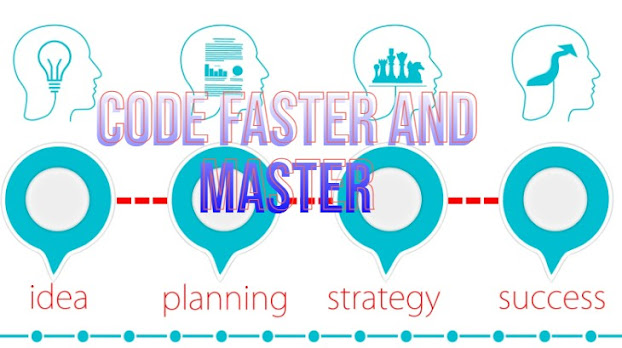Writing code faster and improving performance involves a combination of efficient coding practices, good algorithms, and optimization techniques. Here are some tips to help you achieve both speed and performance in your code:
1. How to Writing Code Faster:
Plan Before You Code:
- Spend some time planning and designing your code before you start typing.
- Clearly define the problem, break it into smaller tasks, and outline a solution.
Use Code Snippets and Templates:
- Create and use code snippets or templates for commonly used patterns.
- Take advantage of the integrated development environment (IDE) features for auto-completion.
Master Keyboard Shortcuts:
- Learn and use keyboard shortcuts in your development environment to navigate and edit code more efficiently.
- Familiarize yourself with your IDE's features for code generation and refactoring.
Follow Coding Standards:
- Adhere to a consistent coding style and follow established coding standards.
- Use Linters or code Formatters to automatically enforce coding conventions.
Automate Repetitive Tasks:
- Automate repetitive tasks, such as building, testing, and deployment.
- Use build tools and scripts to streamline your development workflow.
Use Version Control:
- Embrace version control systems like Git to track changes and collaborate with others.
- Branch and merge strategically to manage different features or bug fixes concurrently.
Write Modular Code:
- Break down your code into smaller, modular functions or classes.
- Modular code is easier to understand, test, and maintain.
Effective Debugging:
- Master debugging tools and techniques to quickly identify and fix issues.
- Use logging statements strategically to trace the flow of your program.
Continuous Learning:
- Stay updated on new programming languages, frameworks, and tools.
- Regularly practice coding and participate in coding challenges or projects.
Write Documentation:
- Document your code to make it more understandable for yourself and others.
- Include comments where necessary, especially for complex or non-intuitive code.
2. Improving Code Performance:
Profile Your Code:
- Identify performance bottlenecks using profiling tools.
- Focus on optimizing the critical sections of your code.
Optimize Algorithms:
- Choose the most efficient algorithms for your specific problem.
- Optimize time and space complexity by selecting the right data structures.
Minimize I/O Operations:
- Reduce disk and network I/O operations, as they are usually slower.
- Optimize database queries and cache frequently used data.
Efficient Looping:
- Minimize the number of iterations in loops and avoid unnecessary computations.
- Utilize vectorized operations or parallel processing where applicable.
Memory Management:
- Avoid memory leaks and unnecessary memory allocations.
- Use appropriate data structures and choose data types with minimal memory overhead.
Lazy Loading and Caching:
- Implement lazy loading for resources and data to load only what is necessary.
- Use caching mechanisms to store and reuse computed results.
Concurrency and Parallelism:
- Explore opportunities for parallel processing or concurrency.
- Use threading or asynchronous programming where applicable.
Optimize Database Queries:
- Properly index database tables and optimize queries.
- Consider denormalization for read-heavy operations.
Minimize External Dependencies:
- Limit external dependencies to only what is necessary for your application.
- Unused or excessive dependencies can impact performance.
Regular Testing:
- Create comprehensive test suites to catch performance regressions early.
- Use profiling tools during testing to identify and address performance issues.
- 3. How to Optimizing a database
Optimizing a database involves several strategies to enhance its performance, reduce response times, and ensure efficient resource utilization. Here are some general tips for optimizing a database:
1. Indexing:
- Properly index columns used in search conditions, joins, and order by clauses.
- Regularly review and update indexes based on changing query patterns.
- Be cautious not to over-index, as it can lead to performance degradation during insert, update, and delete operations.
2. Query Optimization:
- Write efficient queries by avoiding unnecessary joins and selecting only the necessary columns.
- Use appropriate data types for columns to reduce storage space and improve query performance.
- Utilize the EXPLAIN statement or query plan tools to analyze and optimize query execution plans.
3. Normalization and Denormalization:
- Normalize your database to eliminate redundancy and maintain data integrity.
- Consider denormalization for read-heavy operations to reduce the number of joins and improve query performance.
4. Database Design:
- Design tables and relationships with scalability in mind.
- Use appropriate data types, avoid excessive use of nullable columns, and minimize the use of generic columns like VARCHAR(MAX).
5. Partitioning:
- Implement table partitioning to distribute data across multiple physical storage locations.
- Partitioning can improve query performance and simplify data management.
6. Optimize Joins:
- Ensure that join operations are efficient by having proper indexes on join columns.
- Use INNER JOINs instead of OUTER JOINs whenever possible.
7. Caching:
- Implement caching mechanisms to store frequently accessed data in memory.
- Use database caching solutions or application-level caching to reduce the load on the database.
8. Connection Pooling:
- Implement connection pooling to reuse database connections, reducing the overhead of opening and closing connections for each query.
9. Regular Maintenance:
- Regularly update statistics to help the query optimizer make better decisions.
- Perform routine database maintenance tasks such as rebuilding indexes and updating statistics.

Comments
Post a Comment